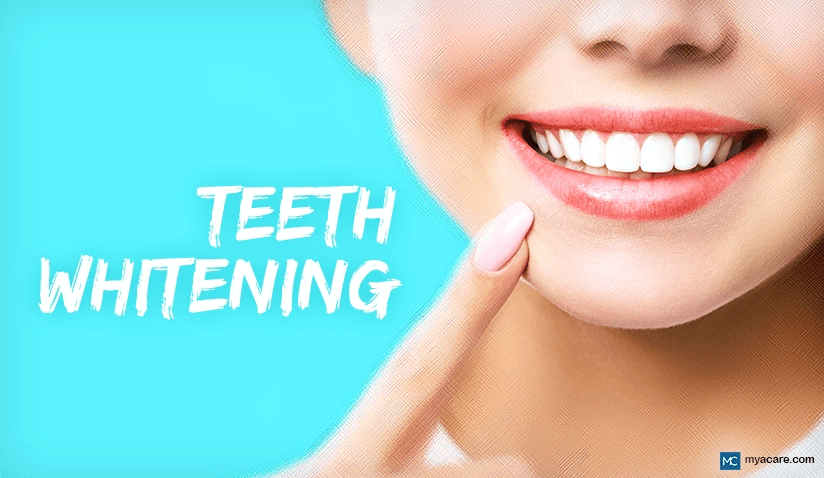Teeth Whitening: Things One Should Know

With growing consciousness of one’s appearance, there is an increasing desire to have white and bright teeth. People consider sparkling white teeth attractive and associate them with good oral hygiene. According to a survey by the American Academy of Cosmetic Dentistry, when asked about what people would like to change about their smile, most desired whiter teeth. This has resulted in a huge demand and market for teeth whitening procedures. This article discusses things one needs to know before going for a teeth-whitening procedure.
Teeth whitening, also known as teeth bleaching procedure involves the use of chemicals (bleaching agents) which lighten the color of discolored teeth. This procedure can be performed by patients at home under a specialist’s guidance or in the dental office by a professional.
Why Do Teeth Discolor?
Over time, teeth may turn yellow or may look dull in appearance. Discoloration of the tooth can result from extrinsic or intrinsic stains.
Extrinsic stains: Extrinsic stains are superficial stains that affect the external surface of the tooth. These stains result from:
- Intake of pigmented food and beverages (e.g., tea, coffee, red wine, cola drinks)
- Lifestyle habits (e.g., smoking, chewing tobacco)
- Poor oral hygiene
- Exposure to metal salts (e.g., iron or copper)
Intrinsic stains: Intrinsic stains discolor the tooth from the inside (from within the inner layers of the tooth). This can result from:
- Genetic disorders that affect the appearance of the tooth (e.g., Dentinogenesis imperfecta, Amelogenesis imperfecta)
- Fluorosis (Excess fluoride intake during the stage of teeth formation)
- Aging (Aging increases the translucency of enamel, making inner yellower dentin more evident)
- Medications (e.g., long-term use of antihistamines, antipsychotics, and high blood pressure medications)
- Other reasons such as presence of decay, trauma to the tooth, amalgam fillings, and excess use of chlorhexidine mouthwash
What Are The Different Tooth Whitening Procedures?
The different tooth whitening procedures are:
- Over-the-counter bleaching products
- In-office bleaching
- At-home bleaching
Over-the-counter Bleaching Products
One may use over-the-counter bleaching products such as whitening toothpaste, teeth whitening gels, mouth rinses, and teeth-whitening strips. These products are effective against extrinsic stains present on the surface of the teeth. The concentration of the bleaching agent is far lower than the products used in the dental office, and so the products are safe to use. Make sure to look for products with an ADA seal of acceptance. However, such over-the-counter products are not useful in whitening intrinsic stains present on teeth.
In-office Bleaching
In-office bleaching includes teeth whitening procedures in the dental office setting. Hydrogen peroxide is the most commonly used in-office bleaching agent. It is used in the different gel concentrations of 15%-38%. This whitening procedure is often carried out in combination with high-intensity blue light to improve effectiveness. During this procedure, a protective gel is applied to protect the gums. Later, a whitening gel is applied to the surface of the teeth and exposed to a light source. Within 1 hour of application, teeth appear brighter. Hydrogen peroxide is a strong bleaching agent and is the fastest way of attaining the whitening effect. One may need to visit the dental office once or twice to undergo this procedure.
At-home Bleaching
For at-home bleaching, a dentist provides custom-fit trays. These trays are contoured to fit one’s teeth so that whitening agent is evenly distributed. A dentist guides on how to dispense whitening agent into these trays. The trays are to be worn for 1-8 hours for several weeks depending on the type of stain and concentration of bleaching agent used. The most common bleaching agent is carbamide peroxide, present in the concentration of 5% to 35%. Overnight use of 10% carbamide peroxide in custom-fitted trays is most common. This process of teeth whitening takes more time and the effect is noticeable in a few days.
How do Whitening Agents Work on Discolored Teeth?
The active ingredient involved in tooth whitening is hydrogen peroxide. Even the carbamide peroxide (used in at-home bleaching), breaks down to release hydrogen peroxide in contact with water. Hydrogen peroxide easily penetrates the tooth layers (enamel and dentin) and breaks the complex stain-causing chemicals (chromogens) into smaller and simpler particles. The smaller particles reflect less light which leads to the lightening of discolored teeth, giving teeth a brighter appearance.
What are the Side Effects of Teeth Whitening?
Tooth whitening procedures are considered the least aggressive method to treat the discolored tooth. However, these procedures are associated with some side effects. These include:
- Sensitivity of teeth: Transient sensitivity of teeth is common after a tooth whitening procedure. This is more evident if a high concentration of whitening agents is used for a prolonged time. This can be managed with the application of anti-sensitivity agents.
- Gum irritation: When peroxide-based whitening agents come in direct contact with gums, they may result in gum irritation. It usually happens when custom-made trays are poorly fitted or a protective barrier is improperly applied, allowing seepage of the whitening agent into the gums. In such scenarios, the patient complains of burning sensation and discomfort. This can be avoided with the proper application of the protective gel.
How Long is the Teeth Whitening Effect Evident?
Teeth whitening effect is not a permanent change. It may vary from person to person and lasts up to 3 years. Frequent consumption of beverages or pigmented foods can stain teeth at a faster rate.
How to Decide Which Procedure is Best Suited?
It’s always better to consult a dentist before one decides on how to whiten their teeth. Depending on the type of stains present, the dentist will inform about the best options. Teeth whitening procedure may not be always recommended for all types of discoloration. For instance, yellow teeth respond well to the bleaching. However, brown and gray teeth may not respond to bleaching. Also, crowns, veneers, or fillings do not bleach at all. The effectiveness of the teeth whitening procedure depends on the time and concentration of the whitening agent used. In-office whitening offers immediate results under professional guidance along with sufficient protection of gums. Alternatively, at-home whitening is more affordable and can be performed in the comfort of one’s home. But one needs to be compliant for effective results.
How Safe are Teeth Whitening Procedures?
Teeth whitening procedures are safe and effective. However, the use of at-home whitening products may sometimes lead to pain in the gum and teeth sensitivity. One should consult a dentist for viable options based on habits, budget, and expectations of desired results.
To search for the best dentists in Germany, India, Malaysia, Poland, Singapore, Spain, Thailand, Turkey, the UAE, the UK and the USA, please use the Mya Care search engine.
To search for the best healthcare providers worldwide, please use the Mya Care search engine.

Dr. Shilpy Bhandari is an experienced dental surgeon, with specialization in periodontics and implantology. She received her graduate and postgraduate education from Rajiv Gandhi University of Health Sciences in India. Besides her private practice, she enjoys writing on medical topics. She is also interested in evidence-based academic writing and has published several articles in international journals.
References:
Featured Blogs



